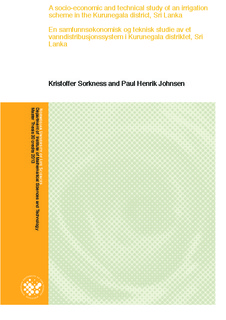| dc.contributor.author | Johnsen, Paul Henrik | |
| dc.contributor.author | Sorkness, Kristoffer | |
| dc.date.accessioned | 2014-02-11T11:02:45Z | |
| dc.date.available | 2014-02-11T11:02:45Z | |
| dc.date.copyright | 2013 | |
| dc.date.issued | 2014-02-11 | |
| dc.identifier.uri | http://hdl.handle.net/11250/189160 | |
| dc.description.abstract | This current study revolves around the Deduru Oya project in Sri Lanka and its interaction between old irrigation schemes and new-built ones. The right-bank canal or RB-canal, a 33 km long canal built in concrete is designed to distribute water from the new-built Deduru Oya reservoir to the older Inginimitiya reservoir, and to the smaller water tanks along the canal. The project is due operational in November 2013. The goal of the project is to meet the water requirements for the paddy fields in the Kurunegala district and to enable farmers to grow paddy (rice) two times a year instead of one, both in the wet Maha season, and in the dry Yala season. The Maha growing season is mostly dependent on precipitation, while the Yala season mostly is dependent on irrigation.
Through a series of structured interviews and simulations through the water resources program WEAP, the study looks deeper into the effects of the RB-canal and to what extent the expectations would answer to the reality. Several scenarios such as different canal flow, climate changes and irrigation improvement were implanted in the simulation program.
The results from the analysis show that the Deduru Oya project will have a positive effect on the paddy cultivation, increasing the yield. We see that the project will be able to supply enough water for the proposed paddy areas along the canal, as well as for the paddy areas downstream of the Inginimitiya reservoir. With scenarios regarding reduced precipitation, increased precipitation intensity and droughts expected to come with climate changes in this arid area, the reservoirs storage capacity will be crucial to store up and supply irrigation water throughout the year.
The people in the affected areas are well aware of chronic water diseases, but have little faith in the government and how they will handle this problem. Pipe born water in these areas are unusual and according to the National Water Supply and Drainage Board there is no existing plan of this being developed in the nearest future. Since the canal is not yet operational and the information from the government very limited, the people today live in uncertainty regarding how their future will develop with this project. | no_NO |
| dc.description.sponsorship | Norsk Vannforening, University of Life Sciences | no_NO |
| dc.language.iso | eng | no_NO |
| dc.publisher | Norwegian University of Life Sciences, Ås | |
| dc.subject | Irrigation | no_NO |
| dc.subject | Sri Lanka | no_NO |
| dc.title | A socio-economic and technical study of an irrigation scheme in the Kurunegala District, Sri Lanka | no_NO |
| dc.title.alternative | En samfunnsøkonomisk og teknisk studie av et vanndistribusjonssystem i Kurunegala distriktet, Sri Lanka | no_NO |
| dc.type | Master thesis | no_NO |
| dc.subject.nsi | VDP::Mathematics and natural science: 400 | no_NO |
| dc.subject.nsi | VDP::Technology: 500 | no_NO |
| dc.source.pagenumber | 114 | no_NO |
